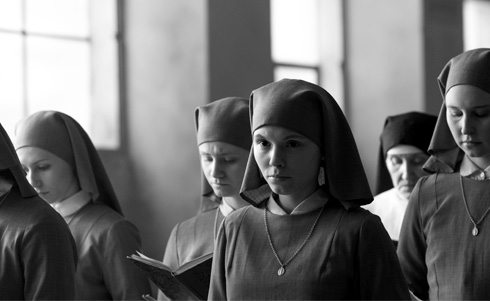The slow-paced beauty of Ida
Ida attempts to return us to a time and place of early 60s Poland where the memories and bones of World War II lay barely covered by snow and earth. Anna (Agata Trzebuchowska) is a young soon-to-be nun who is directed by her Mother Superior to visit her sole surviving relative, her aunt, before taking her vows. On first meeting Wanda (Agata Kulesza) Anna is told with a detached flippancy that pervades Wanda’s actions that that her original name was Ida Lebenstein and that her parents were Jews murdered during the Nazi occupation of Poland. Ida’s response is indicative of her learned habits: her dark, expressionless eyes widen, but she remains almost unmoved. Wanda initially plans to return Ida to the convent the next day, but instead they set out on a journey to discover the fate and resting place of Ida’s parents and brother in order to lay their remains in a family grave.
Shot in stark black and white and 1.37:1 ratio, Ida seems to attempt to place the viewer in its time period, but this seems like a purely formal shift that is overwritten by many other factors. While the high-quality image may make some recall the polished look of Czech New Wave films, I still saw the film as a contemporary look at the past rather than a dive into the past itself. Despite this, the framing and lack of colour results in stunning shots that highlight Wanda’s detachment from the world around her as a small time judge (she flatly informs Ida that she was once referred to as ‘Red Wanda’ for the numerous people she sent to death during the Stalinist regime). Wanda seems self-assured in her detachment: chain smoking; drinking frequently; enjoying jazz; sleeping with men and generally seeking out whatever pleasures she can while on this journey to excavate the brutal past.
Ida, in contrast, watches everything unfold as her family history is revealed to her and us, staying quiet as Wanda sharply converses with the locals, including the family who now lives in the old family home and collaborated with the Nazi occupying forces to sell out Ida’s mother – Wanda’s sister. While the search occupies the narrative, Ida is by no means action-oriented. The odd framing often situates the characters at the bottom of the screen, cutting off the side of a face or only showing the eyes, while the rest of the screen is filled with a roof or an out-of-focus doorway, dragging the viewers’ eyes to the edges of the screen. These shots are counterposed to exterior long, static shots showing very little movement.
Where Ida really shines is in this movement between shots that draw out time immensely, slowing us down and opening up a new filmic space, and the short sharp action scenes that continue the plot.
While it is imminently clear that memories of the Holocaust occupy the characters, the framing and sublime shots, reminiscent of Cartier-Bresson, allow space for a sombre reflection on the characters’ muted interiority, and time seems to expand in these deep, languorous shots.
Yet as the film develops, the contrast between Wanda’s flippant nihilism and Ida’s removed asceticism is complicated as Wanda has to face the realities of the recent past more and more and Ida confronts a world she has never inhabited; one of jazz, men and drinking.
Where Ida really shines is in this movement between shots that draw out time immensely, slowing us down and opening up a new filmic space, and the short sharp action scenes that continue the plot. There is a definite lineage between Ida and the films of Tarkovsky and to an extent Bergman, while working through character interaction in a very different way. Ida does something new with this legacy through the clear but muted history that surrounds the film and that isn’t expressed through action in order to show personal and national wounds. Instead, through the framing, long shots and relative lack of movement we are confronted with no simple way to view the story. Ida’s trained restraint gives the viewer very little to work with which excellently guides us with her through this contemplation, this attempt to take in the world she is confronting. Though this potentially would have very different effects for a Polish audience.
This lack of simplicity does not entail anything necessarily complicated, but rather an interesting way of engaging with a story that avoids the reduction to a conclusive narrative. The ultimate lack of any real or conclusive progression for either character presents us with an ending that slips between the divide maintained throughout the film between the world-denying Ida and sad hedonism of Wanda.
Here there is an escape from any path of necessary action, of something that would be willed in order to fix a scarred world. I’m reminded of Adorno’s invocation that poetry cannot be written after Auschwitz. Ida seems to skirt that issue by taken a path as yet unknown. The final shot is a vital ethical shot along these lines.
I’m left searching for paths between the common divides of spiritual and bodily exploration, between personal memories and experiences and the often dominating national narratives shown to us; to which I hope Ida has found one out of the divide between religious devotion and memory and Wanda’s nihilistic forgetting.
Image Source: Artificial Eye


Comments